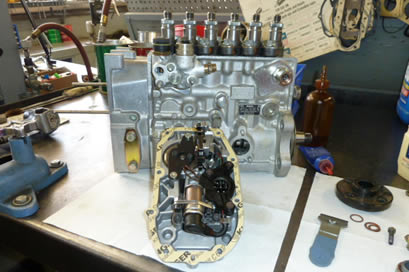TURBO REBUILDING/FUEL SYSTEMS
Having Issues With Your Turbo? Don’t Have A Turbo? Give Us A Call! We Can Rebuild Your Old Turbo, Or Replace It With A Re-manufactured Unit. We Can Also Help You Size A Larger Output Turbo Or Add One If You Don’t Have One On Your Engine. Installing A Turbo Will Give You Much Better Performance Over A Wide Range Of Terrain Than Your Stock Diesel. We Are A Garrett Authorized Center.



Fuel Injection Explained
Fuel injectors come in a number of options. They can be mechanical or electronic, depending on your engine model, and similarly single or multi-spray. They are thoroughly tested to ensure they offer optimum combustion, the highest level of performance, are clean and meet the relevant country’s emission standards. The fuel injector is a major component in the fuel injection system. Its task, simply, is to deliver the right amount of diesel fuel at the right time into the pistons to allow the combustion process to take place. To do so, every time it needs to incorporate: • A measured amount of fuel, according to the model you operate • A timing mechanism for the fuel • A process to atomize the fuel, turning it into a fine spray capable of combustion Fuel injectors deliver the exact volume of fuel needed A fuel injector does all these three things. The fuel injector is shaped like a nozzle. A measured volume of fuel enters it at high pressure and emerges in the chamber surrounding a needle valve, held shut by a spring. That valve will open only when it comes under a pre-set specified pressure and then the fuel is forced into a second, lower chamber and then out into the main combustion chamber of the engine through a series of tiny holes. These small holes have been deliberately designed in order to break the fuel up into fine drops – the process known as atomization – to create a mist that will com-bust easily when exposed to the intense pressures that are generated in the cylinder itself. Immediately after this, the injection pump or timing valve will cut off the fuel supply and the spring compression forces in the needle will shut it again. Depending on the model of engine you have, the fuel injectors will either be mechanically or electrically controlled and they will feature single or multi-spray atomizers.



Fuel Injection Pump Maximizes Power
A fuel injection pump is a very complex piece of engineering. Each one is calibrated to deliver just the right quantity of fuel via the fuel injector into the combustion chamber. This ensures the maximum power output and optimum fuel efficiency. Although their complexity makes it complicated to replace individual parts, it is relatively easy to fit entire replacement units into place. In most cases, the injection pump is driven indirectly from the crankshaft by gears, chains or a toothed belt – often the timing belt – that also drives the camshaft. It rotates at half the speed of the crankshaft in a conventional 4 stroke engine. The timing is precisely set according to the model of engine it services, so that the fuel injection pump introduces the right volume of diesel into the cylinder chamber only a fraction of a second before the cylinder reaches the top dead center position of its compression stroke. This ensures the fuel only becomes available from the fuel injector at the critical point of the cycle. At this point, the heat generated from the very high compression in the piston causes the diesel fuel to ignite, generating power for the engine.



